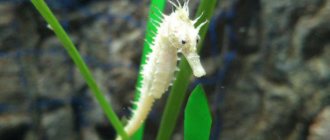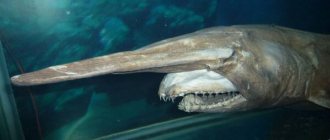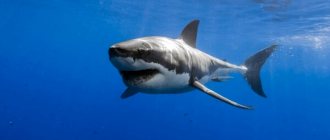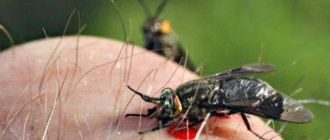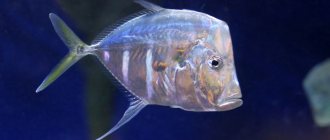The blue shark is part of the large family of gray sharks (Carcharhinidae). It is the only species of the genus Prionace (P. glauca).
It is worth noting that the vast majority of carcharine sharks are a classic type of predatory shark, which is also dangerous to humans.
Moreover, representatives of this family live both in the open ocean and in coastal waters (sometimes not disdaining freshwater bodies of water).
The blue shark is one of the most common in the entire superorder of Selachians. It prefers warm waters of the subtropical or temperate zone, however, even swimming to the shores of Northern Norway.
Appearance
The back of the blue shark is painted indigo, the sides of the individual are bright blue. The belly is usually greyish. This coloring is of a camouflage nature: bottom dwellers simply do not notice blue sharks because they mix with sunlight.
The shark's body is elongated; this predator has large pectoral fins, a conical snout and large eyes. There are approximately 5 pairs of gills on each side. Females are usually larger than males. The body length varies from 2 to 3 meters. The female weighs 93-182 kg, and the male approximately 50 kg. The maximum registered weight is 390 kg.
The teeth of the blue shark are very sharp, the upper killing tools are triangular in shape and concave inward. The teeth located on the lower jaw are awl-shaped. This sea creature has grooves on its face that help it capture odors better. That’s why blue sharks can smell a drop of blood several tens of kilometers away. The shark's nostrils have a groove and special folds called nasal valves. The third eyelid protects the eyes.
The pectoral fins are sickle-shaped. The anterior dorsal fin is much more massive than the second. The blue shark has a long caudal peduncle that is flattened on the sides.
The skin scales of this sea dweller are small, they fit tightly to each other. This is why shark skin is soft and smooth.
Blue shark: habitats, origin
The habitat of these sea queens is limited primarily to the Indian and Pacific oceans. This suggests that this species is a heat-loving adherent of calm waters. However, they are occasionally spotted in areas of Argentina or New Zealand. In its constant search for prey, the blue shark may end up in waters near Norway or even Iceland. Unlike its many relatives, it rarely migrates over long distances. When there is a sufficient amount of food and favorable climatic conditions, the likelihood that this species will go on a long journey across the seas and oceans is relatively small.
Where does it live?
The blue shark lives in temperate and tropical waters. It is often found in the waters off Norway and Denmark. The shark is an inhabitant of the Adriatic and Aegean Seas, and also lives in the waters of the Ionian Sea. The predator lives at a depth of about 350 m. The most pleasant temperature for a shark is 7-16 °C. However, it can be found in places with temperatures around 21 degrees.
This shark migrates frequently. Young and mature males often spend the winter near the Gulf Stream, but most males prefer to do so off the coast of South America. Females living in England swim about 700 miles.
Amazing coloring
It belongs to the subspecies of gray sharks, which have always been famous for their predatory grip and high speed of movement. The shark (blue) fish got its name, like many others, as a result of its bluish-blue color. Its back is predominantly dark blue, its sides are pale blue, and its belly is white. More recently, this inhabitant of the deep waters was one of the most common fish on the planet. But today the population of these majestic and graceful predators is rapidly declining. Perhaps their numbers will soon reach a critically low level. After all, cases are becoming more frequent when very young individuals who have not yet had time to acquire offspring end up in the nets of experienced sailors.
Reproduction
Females reach sexual maturity at 5 or 6 years, and males only at 4-5 years. Cavaliers unusually show affection by biting females. Expectant mothers have fairly thick skin, so no marks remain. Males most often bite the back, namely the place between the first and second fin.
Individuals mate near the continental shelf. The male and female do not contact after this. Sharks mate with several individuals.
Sperm can remain in the expectant mother’s body for a very long time: from a month to several years. This continues until ovulation occurs.
Pregnancy can last 9-12 months. Females give birth in fairly cold waters. From 25 to 50 sharks can be born. The length of a newborn is about 30 cm. These marine predators are fully formed at the time of birth. The cubs remain in subarctic waters until they reach sexual maturity, and then migrate to tropical waters.
Standard diet
What can be said about the diet of these conquerors of the deep sea? This factor depends on the habitat, namely the coastal or more distant oceanic zone. A wide variety of marine life is found at different depths, so sharks have to take this natural factor into account when searching for food. And they cope with this problem very well. Far from the shore, the blue shark feeds on small fish: herring, mackerel or sardines, and sometimes also includes squid in its diet. The coastal zone is richer in living creatures than the deep sea. Therefore, near the shore you can often profit from small fish, waterfowl and waste, which is what the blue shark does. Descriptions of her naval exploits often evoke admiration. And this is with the condition that she practically does not distinguish colors! However, this disadvantage is fully compensated by an impeccable sense of smell and remarkable contrast perception.
Now a little about how the blue shark reproduces. Descriptions of many scientific publications indicate that this species belongs to viviparous sharks. Pregnancy lasts on average from nine to twelve months. A distinctive feature is the number of newborn sharks. There can be from four to hundreds! The mother prefers to breed in warm coastal waters. Despite the large brood, only a few go on further voyages. This is often associated with illegal fishing, as a result of which poachers catch many young and immature individuals.
On the verge of extinction
Be that as it may, the blue shark is a beautiful and strong animal that causes much less harm to a person than he does to her. Shark fin soups, so beloved by many gourmets, have become the cause of their mass extermination. The authorities are taking all possible measures. Despite this, the population of these majestic marine inhabitants is inevitably declining. Unfortunately, everything depends on the consciousness of each person individually. However, there is still a ghostly hope that the blue shark will never disappear from the pages of history.
Shark steak with vegetable stew and porcini mushrooms
To prepare this dish we will need:
- Fresh frozen shark meat (steak) – 400 g.
- Tomatoes on a branch – 3 pcs.
- Red pepper – 1 pc.
- Red onion – 1 pc.
- Lemon – 1 pc.
- Fresh frozen porcini mushrooms – 300 g.
- Dill greens – 0.5 bunch.
- Pepper mixture – 1 tsp.
- Chicken egg – 1 pc.
- Breadcrumbs, vegetable oil, salt.
Preparation:
- Remove the skin and central cartilage from the shark steak. Makes 2 pieces - for 2 servings. Pour lemon juice over the meat, sprinkle with a mixture of peppers and leave to marinate for 1 hour. There is no need to salt the shark.
- Cut the onion into thin rings, tomatoes into slices, and pepper into strips. The seeds and stalk of the pepper must first be removed. Boil the mushrooms in salted water for 20 minutes, then drain the water.
- Break the egg into a bowl, beat well and dip the fish fillet into it, then roll in breadcrumbs and fry in oil on both sides until cooked (15-20 minutes).
- Sauté the onion in a small amount of oil for 3-5 minutes, then add the sweet pepper and cook for another 5 minutes, then add the tomatoes, salt and cook for another 5-10 minutes.
- In a separate frying pan, lightly fry the mushrooms, cutting them in half.
- Place shark steak, vegetable stew and porcini mushrooms on a plate. Bon appetit!
Shark steak recipe with exotic seasoning
Ingredients for a tropical dish:
- Shark steak 175 g – 4 pcs.
- For the marinade:
- Olive oil – 120 ml.
- Lemon juice - to taste.
- Pressed garlic – 3 cloves.
- Fresh chopped coriander – 1 tbsp.
- Ground Roman cumin – 1 teaspoon.
- Cayenne pepper – 1 pinch.
- Salt and black pepper - to taste.
- For the exotic seasoning:
- Pineapple – 300 g.
- Papaya or mango – 1 pc.
- Red pepper – 1 pod.
- Green chili pepper – 1 pod, or red chili pepper – 1 tablespoon.
- Chopped fresh coriander - 2 tablespoons.
- White wine vinegar – 1 tbsp.
- Sugar - to taste.
Preparation:
- Prepare the marinade.
- In a mold, combine olive oil, lemon juice, garlic, coriander, Roman cumin and cayenne pepper. Season with salt and pepper. Place the shark steaks in the marinade, cover tightly with a lid or film and marinate in the refrigerator for about 1 hour.
- Prepare tropical seasoning.
- In a bowl, combine pineapple, papaya or mango, red pepper, chilli, coriander and vinegar. Season with salt and pepper.
- Remove steaks from marinade, reserving marinade. Place steaks under hot grill and cook, basting with marinade, 3 to 5 minutes (depending on thickness) on each side until fish is white and meat flakes easily.
- Serve the steaks hot, sprinkle with seasoning.
- We wish you a bright tropical mood!
Notes
- Life of animals. Volume 4. Lancelets. Cyclostomes. Cartilaginous fish. Bony fishes / ed. T. S. Rassa, ch. ed. V. E. Sokolov. — 2nd ed. - M.: Education, 1983. - P. 39. - 575 p.
- ↑ 12
Gubanov E. P., Kondyurin V. V., Myagkov N. A. Sharks of the World Ocean: A Guide. - M.: Agropromizdat, 1986. - P. 144. - 272 p. - Lindberg, G. W., Gerd, A. S., Russ, T. S.
Dictionary of the names of marine commercial fish of the world fauna. - Leningrad: Science, 1980. - P. 42. - 562 p. - Reshetnikov Yu. S., Kotlyar A. N., Rass T. S., Shatunovsky M. I.
Five-language dictionary of animal names. Fish. Latin, Russian, English, German, French. / under the general editorship of academician. V. E. Sokolova. - M.: Rus. lang., 1989. - P. 32. - 12,500 copies. — ISBN 5-200-00237-0. - Moiseev R. S., Tokranov A. M. et al.
Catalog of vertebrates of Kamchatka and adjacent marine areas. - Petropavlovsk-Kamchatsky: Kamchatka Printing Yard, 2000. - P. 16. - ISBN 5-85857-003-8. - [www.fishbase.org/identification/SpeciesList.php?genus=Prionace Species of the genus Prionace
] in the FishBase catalog database - ↑ 1 2 3 4 5 6 7 Compagno, Leonard JV
2. Carcharhiniformes // [www.fao.org/docrep/009/ad123e/ad123e00.htm FAO species catalogue]. - Rome: Food and Agricultural Organization of the United Nations, 1984. - Vol. 4. Sharks of the World: An Annotated and Illustrated Catalog of Shark Species Known to Date. — P. 455–457. — ISBN 92-5-101383-7. - ↑ 12
[www.fishbase.org/Summary/speciesSummary.php?genusname=Prionace&speciesname=glauca Blue Shark] in the FishBase database (English) - Geoffrey Cox & Malcolm Francis.
Sharks and Rays of New Zealand. - Canterbury University Press, 1997. - 64 p. — ISBN 0-908812-60-4. - Scholz, Tomáš; Euzet, Louis; Moravec, František (1998). “Taxonomic status of Pelichnibothrium speciosum
Monticelli, 1889 (Cestoda: Tetraphyllidea), a mysterious parasite of
Alepisaurus ferox
Lowe (Teleostei: Alepisauridae) and
Prionace glauca
(L.) (Euselachii: Carcharinidae).”
Systematic Parasitology 41
(1): 1-8. DOI:10.1023/A:1006091102174. - Lopez, S., Abarca, N., Meléndez, R. (2013). "[web.archive.org/web/20140713001800/tropicalconservationscience.mongabay.com/content/v6/TCS-2013_Vol_6%281%29_126-137_Lopez_et_al.pdf Heavy Metal Concentrations of two highly migratory sharks ( Prionace glauca
and
Isurus oxyrinchus
) in the southeastern Pacific waters: comments on public health and conservation].
Tropical Conservation Science 6
(1): 126–137. ([news.mongabay.com/2013/0318-kimbrough-tcs-sharks.html#oW2do4oAQLssXMSk.99 summary]) - [web.archive.org/web/20060504192213/homepage.mac.com/mollet/Pg/Pg_captive.html Blue Shark ( Prionace glauca
) in captivity] (English) (Retrieved April 20, 2012)
Nutrition
- 100 facts about bears
- Jungle animals
- Saber-toothed tiger
- 50 facts about kangaroos
- long eared hedgehog
- Cross spider
The main food for blue sharks are schooling ocean fish: tuna, mackerel, herring, etc. A significant portion of the diet consists of squid. You can often see a picture where a predator caught in a dense school of squid fills its belly so tightly with the delicate bodies of mollusks that it can no longer swallow them. Then the shark regurgitates the excess food and continues to greedily grab the prey.
Open ocean waters do not often contain so much food, so the predator instinctively tries to create reserves in the body. This usually relatively sedentary shark completely transforms at the sight of food. Often, a school of blue sharks experiences a well-known state of hunger frenzy, or food fever. At such moments it is especially dangerous to be close to predators. The blue shark is not picky when choosing food - it can consume any organic matter, including carrion. Sometimes blue sharks accompany slow-swimming sea vessels for a long time, eating ship waste.
